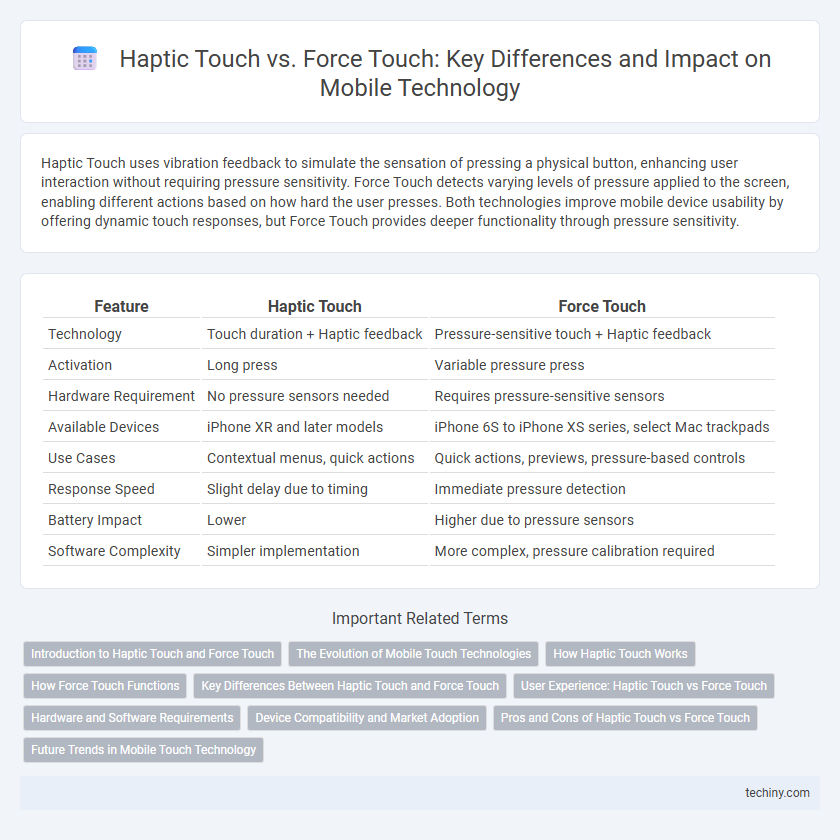Haptic Touch uses vibration feedback to simulate the sensation of pressing a physical button, enhancing user interaction without requiring pressure sensitivity. Force Touch detects varying levels of pressure applied to the screen, enabling different actions based on how hard the user presses. Both technologies improve mobile device usability by offering dynamic touch responses, but Force Touch provides deeper functionality through pressure sensitivity.
Table of Comparison
| Feature | Haptic Touch | Force Touch |
|---|---|---|
| Technology | Touch duration + Haptic feedback | Pressure-sensitive touch + Haptic feedback |
| Activation | Long press | Variable pressure press |
| Hardware Requirement | No pressure sensors needed | Requires pressure-sensitive sensors |
| Available Devices | iPhone XR and later models | iPhone 6S to iPhone XS series, select Mac trackpads |
| Use Cases | Contextual menus, quick actions | Quick actions, previews, pressure-based controls |
| Response Speed | Slight delay due to timing | Immediate pressure detection |
| Battery Impact | Lower | Higher due to pressure sensors |
| Software Complexity | Simpler implementation | More complex, pressure calibration required |
Introduction to Haptic Touch and Force Touch
Haptic Touch utilizes simple vibration feedback to simulate physical interactions on mobile screens, improving user engagement and accessibility. Force Touch detects varying pressure levels applied to the screen, enabling additional input options and deepening interaction capabilities. Both technologies enhance touchscreen functionality by introducing tactile responses, but Haptic Touch relies on timed touch duration while Force Touch measures applied pressure intensity.
The Evolution of Mobile Touch Technologies
Haptic Touch and Force Touch represent significant milestones in the evolution of mobile touch technologies, enhancing user interaction through tactile feedback and pressure sensitivity. Haptic Touch relies on vibration motors to simulate physical button presses, while Force Touch introduces varying levels of pressure detection, enabling more nuanced input commands. Both technologies have paved the way for more intuitive and immersive mobile experiences by improving precision and responsiveness in touchscreen devices.
How Haptic Touch Works
Haptic Touch simulates physical button presses by using a vibration motor to create tactile feedback when the screen is touched. It detects touch duration and pressure indirectly through software algorithms, which triggers subtle vibrations to mimic the sensation of pressing a real button. Unlike Force Touch, Haptic Touch relies primarily on touch duration without measuring actual pressure levels on the screen.
How Force Touch Functions
Force Touch functions by detecting varying levels of pressure applied to the touchscreen, enabling devices to differentiate between a light tap and a deeper press. This technology relies on capacitive sensors integrated beneath the display that measure tactile force, allowing for context-specific actions like previewing content or accessing shortcuts. By quantifying pressure intensity, Force Touch enhances user interaction beyond simple touch inputs with pressure-sensitive controls.
Key Differences Between Haptic Touch and Force Touch
Haptic Touch relies on long presses combined with tactile feedback via vibration motors, whereas Force Touch detects varying pressure levels applied on the screen using pressure-sensitive sensors. Unlike Force Touch, which supports pressure-sensitive actions such as previewing content or pressure-based drawing, Haptic Touch mainly offers contextual menus triggered by touch duration. Force Touch requires specialized hardware implemented in devices like early Apple Watch models and MacBooks, while Haptic Touch is software-based and more broadly available on recent iPhones.
User Experience: Haptic Touch vs Force Touch
Haptic Touch provides tactile feedback through vibrations, enhancing user interaction by simulating button presses without physical movement, while Force Touch detects varying pressure levels, enabling context-specific actions based on touch intensity. The user experience with Haptic Touch is simpler and more intuitive, as it relies on touch duration instead of pressure sensitivity, improving accessibility and reducing hardware complexity. Force Touch offers richer interaction possibilities but may require a learning curve and precise pressure control, affecting ease of use and consistency across different applications.
Hardware and Software Requirements
Haptic Touch relies on a capacitive touchscreen and software algorithms to simulate physical feedback through vibration motors, requiring less specialized hardware compared to Force Touch. Force Touch requires pressure-sensitive sensors integrated beneath the display, along with firmware and software capable of distinguishing different pressure levels for nuanced interactions. Devices equipped with Force Touch necessitate more advanced hardware calibration and software support to accurately process varying force inputs.
Device Compatibility and Market Adoption
Haptic Touch is widely compatible across a broad range of iPhone models starting from the iPhone XR, contributing to its dominant market adoption due to software-based implementation. In contrast, Force Touch requires specialized hardware sensors, limiting its use to earlier models such as the iPhone 6S through iPhone XS, resulting in reduced compatibility and declining market presence. Manufacturers favor Haptic Touch for enhanced device integration and cost efficiency, driving its prevalence in newer mobile technology ecosystems.
Pros and Cons of Haptic Touch vs Force Touch
Haptic Touch offers consistent tactile feedback through vibrations, improving durability and reducing mechanical complexity compared to Force Touch, which relies on pressure-sensitive hardware to detect varying levels of force for more precise input. While Force Touch enables deeper interaction like pressure-sensitive drawing and shortcuts, it consumes more power and increases device thickness and cost, whereas Haptic Touch provides simpler, energy-efficient feedback but lacks pressure sensitivity. Users benefit from Force Touch's nuanced controls in creative applications, whereas Haptic Touch proves advantageous in general usability and long-term reliability.
Future Trends in Mobile Touch Technology
Haptic Touch and Force Touch represent key innovations in mobile touch technology, with future trends leaning towards more precise pressure sensitivity and enhanced tactile feedback integration. Emerging advancements involve combining ultrasonic and piezoelectric sensors to improve responsiveness and enable multi-dimensional touch inputs. These developments aim to create more immersive user experiences, supporting applications in augmented reality and advanced gesture controls.
Haptic Touch vs Force Touch Infographic

 techiny.com
techiny.com